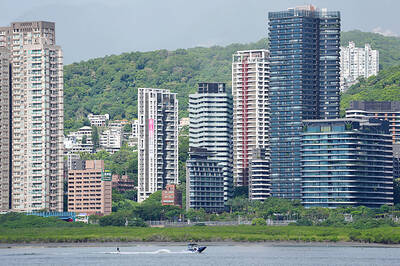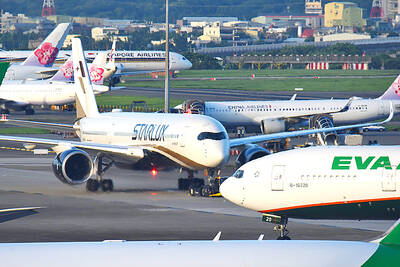Taiwan must accelerate progress in constructing wireless infrastructure in its major cities to catch up in the worldwide trend toward having wireless Internet connections available everywhere, officials and industrialists said yesterday.
They said expanding the infrastructure would help create huge business potential for the industry.
"The prevalence of wireless broadband Internet access will stimulate local companies to develop compatible mobile devices, which is expected to draw orders from overseas since many countries are keen to construct so-called `wireless cities,'" said Jason Chen (陳立生), country manager of Intel Microelectronics Asia Ltd's Taiwan Branch.
Finland, the US, Japan and South Korea are countries that are speeding up promotion of wireless cities, Chen said at a forum.
The South Korean government has pumped huge resources into wireless infrastructure as a way to develop the nation's flat-panel display industry, he said.
Japan's government plans to have Tokyo to become the first city where WiMax -- a technology that can send high-speed broadband signals over a citywide area -- is available everywhere, while in Finland, Nokia Oyj recently announced it would work with Intel to develop handsets that operate using WiMax, he said.
In comparison, wireless Internet connection is only available in small areas of certain cities in this country. Taipei City has the largest coverage, which includes the Xinyi District and 30 mass rapid transit (MRT) stations.
The Taipei City Government plans to bring the service to 50 percent of the population by the end of this month and 90 percent by the end of next year.
Although Taipei has the most hotspots in the nation, the utilization rate is low. According to city government's estimates, on weekdays an average of 450 users access the wireless connection a day in and near the MRT stations, and about 200 people make use of the service in the Xinyi District.
Expanding the hotspots into a hotzone is key to boosting user traffic, as well as attracting more content providers to develop more value-added services, Chen said.
However, networks provided by different telecom carriers should be integrated to allow users access the wireless connections without going through the hassle of applying for different accounts, he said.
Taipei Deputy Mayor King Pu-tsung (
But much more has to be done, Chen said, adding that the largest barrier remains regulations, since the bandwidth is still controlled by the government.
Fortunately, the government has agreed to loosen regulations within six months, said Wong Pu-shan (翁樸山), chairman of the Electrical and Electronic Manufacturers' Association's (電電公會) communications industry alliance.
"The industry is expected to take off in 2008, when various form of communications, including sound, text, image and motion pictures can be integrated in one gadget wherever people go," Wong said.

Taiwan’s rapidly aging population is fueling a sharp increase in homes occupied solely by elderly people, a trend that is reshaping the nation’s housing market and social fabric, real-estate brokers said yesterday. About 850,000 residences were occupied by elderly people in the first quarter, including 655,000 that housed only one resident, the Ministry of the Interior said. The figures have nearly doubled from a decade earlier, Great Home Realty Co (大家房屋) said, as people aged 65 and older now make up 20.8 percent of the population. “The so-called silver tsunami represents more than just a demographic shift — it could fundamentally redefine the

Businesses across the global semiconductor supply chain are bracing themselves for disruptions from an escalating trade war, after China imposed curbs on rare earth mineral exports and the US responded with additional tariffs and restrictions on software sales to the Asian nation. China’s restrictions, the most targeted move yet to limit supplies of rare earth materials, represent the first major attempt by Beijing to exercise long-arm jurisdiction over foreign companies to target the semiconductor industry, threatening to stall the chips powering the artificial intelligence (AI) boom. They prompted US President Donald Trump on Friday to announce that he would impose an additional

China Airlines Ltd (CAL, 中華航空) said it expects peak season effects in the fourth quarter to continue to boost demand for passenger flights and cargo services, after reporting its second-highest-ever September sales on Monday. The carrier said it posted NT$15.88 billion (US$517 million) in consolidated sales last month, trailing only September last year’s NT$16.01 billion. Last month, CAL generated NT$8.77 billion from its passenger flights and NT$5.37 billion from cargo services, it said. In the first nine months of this year, the carrier posted NT$154.93 billion in cumulative sales, up 2.62 percent from a year earlier, marking the second-highest level for the January-September

Asian e-commerce giant Shein’s (希音) decision to set up shop in a historic Parisian department store has ruffled feathers in the fashion capital. Anger has been boiling since Shein announced last week that it would open its first permanent physical store next month at BHV Marais, an iconic building that has stood across from Paris City Hall since 1856. The move prompted some French brands to announce they would leave BHV Marais, but the department store had already been losing tenants over late payments. Aime cosmetics line cofounder Mathilde Lacombe, whose brand was among those that decided to leave following